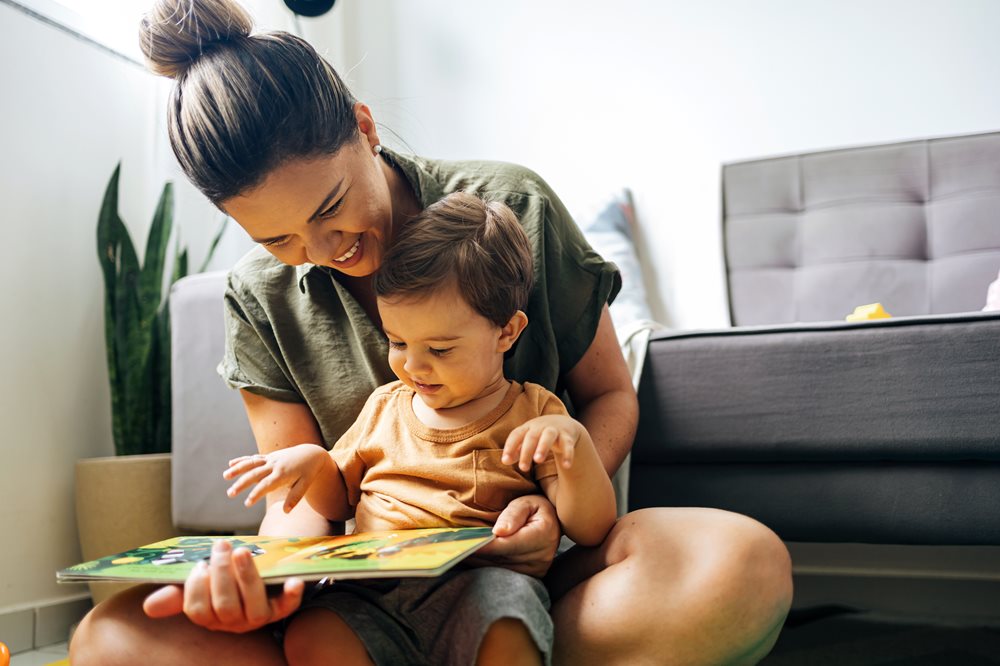Getting Hooked on Books! Choose Books that Spark Your Child’s Interest

Books are a terrific way to build your child’s language and literacy skills. Books allow you to expose your child to new words and ideas, have conversations, and introduce your child to storytelling and to the printed word. Therefore, encouraging your child’s interest in books early on is very important. But if your child isn’t interested in books or doesn’t attend to them for very long, you might need to experiment with different kinds of books to see what catches your child’s interest. Here are some ideas to get your child hooked on books!
Repetitive books
Tip: Try this type of book if your child likes rhythm and music
These books have repeated words or sentences throughout, which provides a rhythm to the text. For example, the book Brown Bear, Brown Bear, What Do You See? by Bill Martin Jr. uses the same sentences on each page with just one word that changes each time: “Brown bear, brown bear, what do you see? I see a … looking at me”. The repetitive rhythm is almost like a song and often catches children’s attention and interest. The rhythm and repetition on each page also help children remember the words and predict which words are coming next.
Books with realistic pictures
Tip: Try this type of book if your child likes to look at photos
For some children, the illustrations in books are too abstract and difficult to understand. They may respond to more realistic, photographic pictures of everyday items and scenes. Children often love looking at and talking about their own personal books made with photos of familiar people and their favourite things. In addition, many “First Words” books for young children include photos of common objects, and this might catch your child’s attention.
Board books and cloth books
Tip: Try these types of books if your child tends to rip the pages
Board books have thick cardboard pages, and cloth books are made out of soft fabric instead of paper. These books tend to be sturdier than books with thin paper pages, and they are a great option if your child tends to rip the pages. Children who are still developing their fine motor skills might also find it easier to turn the thick pages of a board book than a regular paper book.
Books about songs
Tip: Try this type of book if your child likes music
If your child has a favourite song, look for a book based on that song. You can sing the song while your child looks at the pictures. If the song has actions, you can do those too as you sing and share the book. In the video below you’ll meet Andrew, who isn’t really interested in books yet. His mother knows he loves the “Wheels on the Bus” song, so she tries a book based on the song. Watch how this book and the song catches his attention.
Interactive books
Tip: Try this type of book if your child likes to explore things with their senses
These books include things to touch, see, hear, or even smell! Interactive books encourage your child to participate by lifting flaps, pressing buttons to hear sound effects, or scratching and sniffing. These interactive components are often very interesting to young children and might be just the hook they need to get them interested in books! An example of an interactive book is “Where’s Spot?” by Eric Hill, which has flaps on each page to lift and uncover an animal. You can also make your own interactive book by gluing interesting items into an album for your child to touch and feel, such as cotton balls, twigs, sandpaper, shells, or sponges. Or make your own lift-the-flap book by covering some of the pictures in a book with post-it notes.
Books about special interests
Tip: Try this type of book if your child has an interest in a specific topic
If your child is interested in a certain topic – such as outer space, animals, or trains – choosing a book based on this interest can be very motivating. It doesn’t have to be a traditional children’s book; non-fiction (fact-based) books and interest-based magazines (e.g., car magazines) might appeal to your child. The idea is to find reading material that catches your child’s attention and sparks a love of books.
Once you’ve found a book your child likes, you need to think about how to read with your child. It can be helpful to think about sharing books as a time for back-and-forth conversation, with your child leading the conversation. The idea is to encourage your child to share their interests and ideas as you look at the book together. You will read the book to your child to get them familiar with it, but when you read – and especially when you reread the book – wait quietly while watching your child as you turn the page. They will likely show you what’s caught their attention by pointing to something in the book or saying something about it. Then it’s your turn to say something back about what your child just did or said. If you keep following your child’s lead in this way, the “conversation” will keep going back and forth, with both of you sharing your ideas about the book with each other.
Looking for more book ideas? Every month we choose a children’s book and talk about simple ways to use it to build language and literacy skills in our Book Nook.
